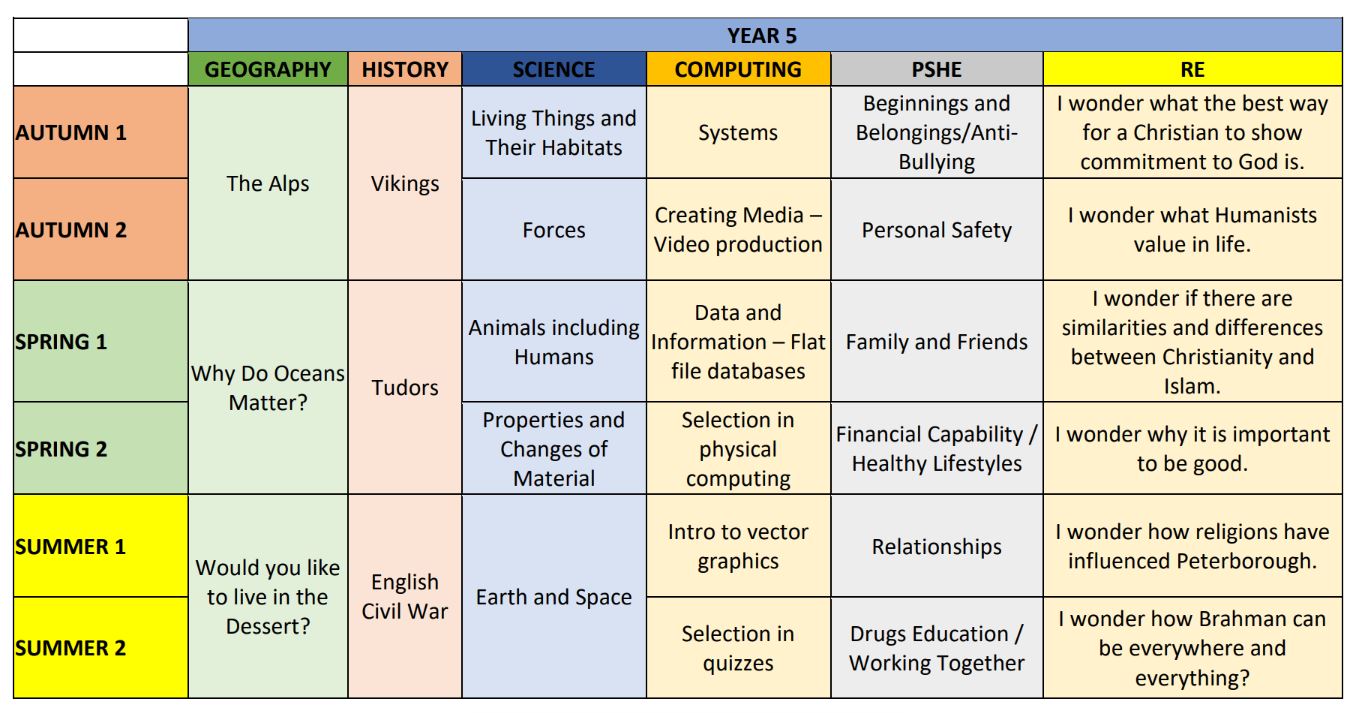Welcome to Year 5
By the time children get to Year 5, rules and expectations are embedded; children know what is expected of them. As nine and ten year olds, the children have a chance to show how mature they are. A really positive year in Year 5 can put children in a great position to show clearly what they can do in the end of Year 6 SATs (Statutory Assessment Tests)!
|
Year 5 has three classes:
|
|
|
5G - Mrs Wilson-Pearce/Mr Green - hwilsonpearce@gpa.education sgreen@gpa.education |
|
|
5T - Mr Thrower - mthrower@gpa.education
|
Throughout the year, the children extend their knowledge and understanding in all curriculum areas, building on knowledge from Year 4.
We aim for children in Year 5 to have a happy and successful year in which they continue to develop a love of learning, embrace challenges and better understand how they learn.
The School Day
The school day in Year 5 for the academic year 2023/2024:
| 8:45am | Gates open and children are welcomed into school - they have an early morning activity to complete whilst registration and dinner choices take place. |
|---|---|
| 9:00am |
Morning curriculum lessons begin. Spanish, music and PE lessons are taught by specialist teachers. Year 5 children have PE on Monday and Wednesday and can arrive to school in their PE uniform. |
| 10:00am | Maths |
| 11:00am | Morning breaktime - bagels are available for pupils as a breaktime snack. |
| 11:15am | English lesson |
| 12:45pm | Lunch |
| 1:30pm | Curriculum lessons |
| 3:00pm | Class story - we read a class together to share our love of reading. |
| 3:15pm | Children are finished for the school day. Children will leave at the end of the day with their reading book, reading record and lots of new knowledge they have learnt throughout the day. Please ask your child what they have learnt today! |
Teachers are available in the main playground at the end of the school day, if you have any questions or wish to arrange a mutually convenient time please see your child's teacher at the end of day.
Alternatively, can you speak to Mrs Mallott (kmallott@gpa.education) or another member of the leadership team.
As designated home-learning, children are expected to set time aside after school to read - at least 20 minutes a day is encouraged.
Parents/carers: Your role in this is essential - simply asking two or three questions about a text can be the difference between a child sitting with a book and skimming through it and a child actually reading for understanding.
Children have PE on Monday and Wednesday; they should have the appropriate kit for both indoor and outdoor PE. PE kits can be worn for the day on these days.
Curriculum
We have a knowledge based curriculum where learning is built over time. Over the course of the year your child will be learning the following:
Reading
During Year 5, children are working towards the following criteria, all of which they should be able to achieve by the end of Year 6:
- Apply their growing knowledge of root words, prefixes and suffixes to read aloud and to understand the meaning of new words that they meet
- Continue to read and recommend an increasingly wide range of fiction (including myths, legends and traditional stories, modern fiction, fiction from our literary heritage), poetry, plays, non-fiction and reference books or textbooks
- Identify and discuss themes and make comparisons within and across books, distinguishing between statements of fact and opinion
- Check that the book makes sense to them, discussing their understanding and exploring the meaning of words in context and asking questions to improve their understanding
- Draw inferences such as inferring characters' feelings, thoughts and motives from their actions, justify their inferences with evidence and predict what might happen from details stated and implied
- Consider the impact on the reader of language, structure and presentation and the author’s use of language, including figurative language
- Retrieve, record and present information from non-fiction
Writing
During Year 5, children are working towards the following criteria, all of which they should be able to achieve by the end of Year 6:
- Spell some words with ‘silent’ letters, distinguish between homophones and other words which are often confused and use dictionaries to check the spelling and meaning of words
- Identify the audience for and purpose of a piece of writing, selecting the appropriate form and using other similar writing as models for their own, selecting appropriate grammar and vocabulary and understanding how such choices can change and enhance meaning
- In narratives, describe settings, characters and atmosphere and integrate dialogue to convey character and advance the action
- Use a wide range of devices to build cohesion within and across paragraphs or other organisational and presentational devices to structure text and to guide the reader
- Ensure the consistent and correct use of tense throughout a piece of writing as well as subject and verb agreement when using singular and plural, distinguishing between the language of speech and writing
- Using expanded noun phrases to convey complicated information concisely, modal verbs or adverbs to indicate degrees of possibility and devices to build cohesion, including adverbials of time, place and number
- Recognise vocabulary and structures that are appropriate for formal speech and writing, including subjunctive forms, passive verbs to affect the presentation of information in a sentence and the perfect form of verbs to mark relationships of time and cause
- Use higher level punctuation such as ellipsis, commas to clarify meaning or avoid ambiguity in writing, brackets, dashes or commas to indicate parenthesis, hyphens to avoid ambiguity and semicolons, colons or dashes to mark boundaries between independent clauses
Maths
During Year 5, children are expected to achieve the following criteria
- Interpret negative numbers in context, count forwards and backwards with positive and negative whole numbers, including through zero
- Read Roman numerals to 1000 (M) and recognise years written in Roman numerals
- Recognise and use more mathematical language such as: square numbers and cube numbers and their the notation; multiples and factors, including finding all factor pairs of a number, and common factors of two numbers; prime numbers, prime factors and composite (non-prime) numbers
- Use rounding to check answers to calculations and determine, in the context of a problem, levels of accuracy
- Multiply and divide whole numbers and those involving decimals by 10, 100 and 1000
- Multiply numbers up to 4 digits by a one or two digit number using a formal written method, including long multiplication for two digit numbers
- Divide numbers up to 4 digits by a one-digit number using the formal written method of short division and interpret remainders appropriately for the context
- Recognise and compare mixed numbers and improper fractions and convert from one form to the other and write mathematical statements > 1 as a mixed number
- Identify, name and write equivalent fractions of a given fraction, represented visually, including tenths and hundredths
- Add and subtract fractions with the same denominator and denominators that are multiples of the same number
- Multiply proper fractions and mixed numbers by whole numbers, supported by materials and diagrams
- Read and write decimal numbers as fractions, round decimals with two decimal places to the nearest whole number and to one decimal place and compare decimals up to 3 decimal places
- Recognise the per cent symbol (%) and understand that per cent relates to ‘number of parts per hundred’, and write percentages as a fraction with denominator 100, and as a decimal
- Measure and calculate the perimeter of composite rectilinear shapes in centimetres and metres
- Calculate and compare the area of rectangles (including squares), and including using standard units, square centimetres (cm²) and square metres (m²) and estimate the area of irregular shapes
- Distinguish between regular and irregular polygons based on reasoning about equal sides and angles
- Identify 3-D shapes, including cubes and other cuboids, from 2-D representations
- Know angles are measured in degrees: estimate and compare acute, obtuse and reflex angles and draw given angles, and measure them in degrees (°)
- Identify, describe and represent the position of a shape following a reflection or translation, using the appropriate language, and know that the shape has not changed
- Complete, read and interpret information in tables, including timetables
Parents and carers, if you wish to discuss any of these areas of learning with your child’s teacher, there are 3 scheduled parent consultations throughout the year and teachers are happy to make appointments before or after school to meet with you.


